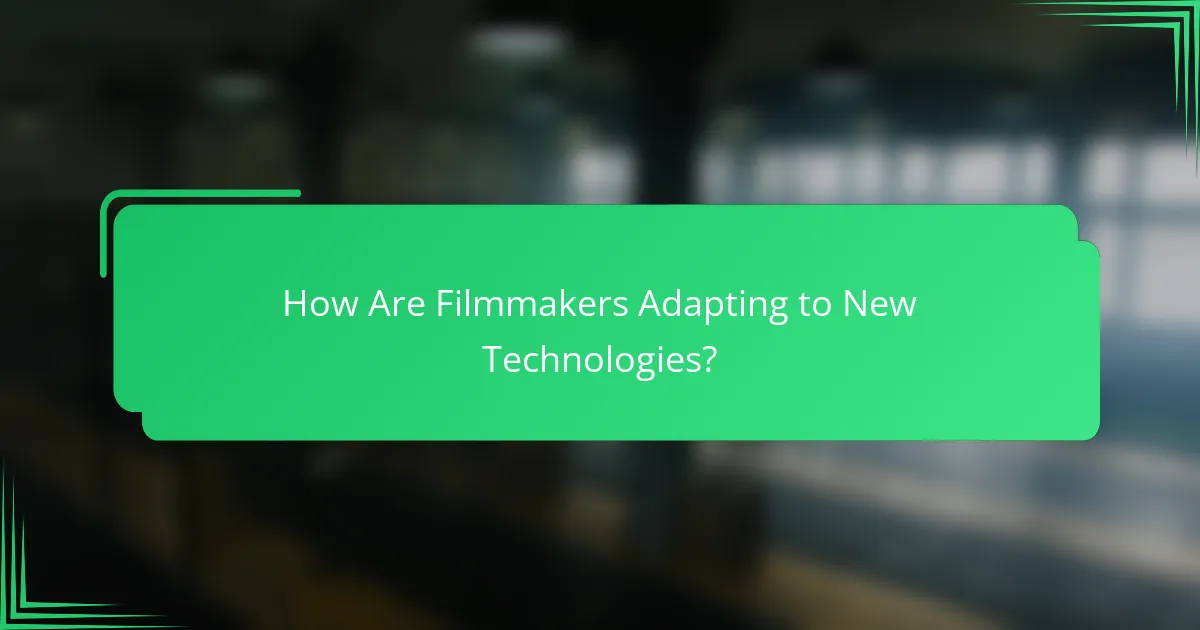Technology is playing a pivotal role in shaping the future of film trends and innovations, revolutionizing both production and distribution processes. With advancements such as virtual reality, artificial intelligence, and streaming platforms, filmmakers are not only enhancing creativity and efficiency but also transforming audience engagement and accessibility. As new tools emerge, the landscape of storytelling continues to evolve, offering exciting possibilities for the cinematic experience.

How Is Technology Transforming Film Production?
Technology is significantly transforming film production by introducing innovative tools and methods that enhance creativity and efficiency. From virtual reality to artificial intelligence, these advancements are reshaping how films are made and experienced.
Virtual reality in filmmaking
Virtual reality (VR) is revolutionizing filmmaking by allowing creators to immerse audiences in interactive environments. Filmmakers can use VR to develop narrative experiences that engage viewers on a deeper level, making them feel part of the story.
Producing VR content requires specialized equipment and software, such as 360-degree cameras and VR editing tools. Filmmakers should consider the unique storytelling techniques that VR demands, including spatial audio and non-linear narratives.
AI-driven script analysis
AI-driven script analysis tools are changing how screenplays are evaluated and developed. These tools can analyze scripts for structure, pacing, and character development, providing insights that help writers refine their work.
By leveraging machine learning algorithms, these platforms can predict audience reactions and suggest improvements. Filmmakers should use these tools to enhance script quality while maintaining their unique voice and vision.
Advanced CGI techniques
Advanced CGI techniques are pushing the boundaries of visual effects in film. Technologies like motion capture and real-time rendering allow for more realistic and dynamic imagery, enhancing storytelling possibilities.
Filmmakers should be aware of the costs and time associated with high-quality CGI production. Balancing practical effects with CGI can create a more authentic experience, so it’s essential to consider the overall aesthetic of the film.
Remote collaboration tools
Remote collaboration tools are essential for modern film production, especially in a globalized industry. Platforms like video conferencing and project management software enable teams to work together effectively, regardless of location.
Using these tools can streamline communication and project tracking, but filmmakers must ensure that all team members are trained to use them efficiently. Establishing clear protocols for collaboration can help avoid misunderstandings and delays.
Cloud-based editing software
Cloud-based editing software is transforming the post-production process by allowing filmmakers to edit and share projects from anywhere. This flexibility enables real-time collaboration among editors, directors, and producers, enhancing productivity.
When choosing cloud-based solutions, filmmakers should consider factors like storage capacity, software compatibility, and security features. Regular backups and version control are crucial to prevent data loss and ensure a smooth editing process.

What Are the Latest Innovations in Film Distribution?
The latest innovations in film distribution focus on enhancing accessibility and efficiency through technology. Key developments include the rise of streaming platforms, the use of blockchain for copyright protection, and the emergence of interactive storytelling formats.
Streaming platforms evolution
Streaming platforms have transformed how films reach audiences, providing on-demand access to a vast library of content. Services like Netflix, Amazon Prime Video, and Disney+ have rapidly evolved, incorporating features such as personalized recommendations and original content production.
As competition intensifies, platforms are exploring tiered subscription models and ad-supported options to attract diverse viewer demographics. This evolution not only influences consumer behavior but also shapes content creation strategies, with filmmakers adapting to platform-specific requirements.
Blockchain for copyright protection
Blockchain technology is gaining traction in the film industry as a means to secure intellectual property rights and streamline distribution. By creating a decentralized ledger, filmmakers can register their works, ensuring transparency and reducing piracy risks.
Some projects are already utilizing blockchain to manage royalties and track usage across platforms, offering a more equitable revenue-sharing model. Filmmakers should consider integrating blockchain solutions to protect their rights and potentially increase their earnings.
Interactive storytelling formats
Interactive storytelling formats are reshaping audience engagement by allowing viewers to influence narrative outcomes. Platforms like Netflix have experimented with choose-your-own-adventure style films, where viewers make decisions that affect the storyline.
This innovation not only enhances viewer immersion but also opens new avenues for content creation. Filmmakers should explore interactive elements to attract tech-savvy audiences and differentiate their projects in a crowded market.

How Are Filmmakers Adapting to New Technologies?
Filmmakers are increasingly embracing new technologies to enhance storytelling, improve production efficiency, and engage audiences. By integrating tools like drones, audience analytics, and social media, they are reshaping the film landscape.
Utilizing drones for cinematography
Drones have revolutionized cinematography by providing unique aerial perspectives that were once costly and difficult to achieve. They allow filmmakers to capture sweeping landscapes and dynamic action shots with relative ease and at a lower cost compared to traditional methods.
When using drones, filmmakers should consider factors such as local regulations regarding airspace and privacy. In many regions, operators must adhere to guidelines set by aviation authorities, which may include obtaining permits or certifications.
Incorporating audience analytics
Audience analytics enable filmmakers to understand viewer preferences and behaviors, informing decisions from script development to marketing strategies. By analyzing data from streaming platforms and social media, filmmakers can tailor content to better meet audience expectations.
To effectively utilize audience analytics, filmmakers should focus on key metrics such as viewer engagement, demographic insights, and feedback trends. This data can guide promotional efforts and even influence casting and plot choices to resonate with target audiences.
Leveraging social media for marketing
Social media has become a vital tool for film marketing, allowing filmmakers to reach audiences directly and create buzz around their projects. Platforms like Instagram, Twitter, and TikTok enable filmmakers to share trailers, behind-the-scenes content, and engage with fans in real time.
To maximize impact, filmmakers should develop a cohesive social media strategy that includes regular updates, interactive content, and targeted advertising. Collaborating with influencers and utilizing hashtags can also enhance visibility and drive interest in upcoming releases.

What Are the Key Trends Shaping the Future of Film?
The future of film is being shaped by several key trends that emphasize technological advancements and evolving audience preferences. These trends include immersive experiences, sustainable production practices, and the integration of augmented reality, each influencing how films are created and consumed.
Rise of immersive experiences
Immersive experiences are transforming the way audiences engage with films, moving beyond traditional viewing. Technologies such as virtual reality (VR) and 360-degree video allow viewers to step into the narrative, creating a sense of presence and participation.
Filmmakers are increasingly exploring these formats, with VR films often designed to be experienced in dedicated spaces or through headsets. This shift requires a different storytelling approach, focusing on interactivity and viewer agency.
Focus on sustainability in production
Sustainability is becoming a critical focus in film production, with many studios adopting eco-friendly practices to reduce their carbon footprint. This includes using renewable energy sources, minimizing waste, and opting for sustainable materials in set design and costumes.
Producers are encouraged to consider sustainability from the pre-production phase, employing practices like digital scripts to reduce paper use and local sourcing to cut transportation emissions. These efforts not only benefit the environment but can also appeal to eco-conscious audiences.
Integration of augmented reality
Augmented reality (AR) is increasingly being integrated into film marketing and storytelling, enhancing viewer engagement. AR applications allow audiences to interact with film content through their smartphones or AR glasses, creating a layered experience that complements the film.
For example, promotional campaigns may include AR elements that provide additional context or interactive features related to the film’s plot or characters. This trend encourages filmmakers to think creatively about how to blend digital content with traditional narratives, expanding the storytelling possibilities.

What Criteria Should Filmmakers Consider When Adopting New Technologies?
Filmmakers should evaluate several key criteria when considering the adoption of new technologies, including cost-effectiveness, integration with current processes, and the potential to enhance audience engagement. These factors can significantly influence both the production process and the final product’s reception.
Cost vs. benefit analysis
Conducting a cost vs. benefit analysis is crucial for filmmakers to determine if a new technology is worth the investment. This involves comparing the upfront costs, such as equipment purchases or software licenses, against the expected benefits, like improved production efficiency or enhanced visual quality.
For instance, investing in high-quality cameras may have a high initial cost but can lead to better cinematic results, potentially increasing box office returns. Filmmakers should aim for technologies that offer a clear return on investment, ideally within a few projects.
Compatibility with existing workflows
New technologies must seamlessly integrate with existing workflows to avoid disruptions in production. Filmmakers should assess whether the new tools can work alongside current software and hardware, minimizing the need for extensive retraining or overhauls.
For example, if a filmmaker uses specific editing software, they should ensure that any new camera technology is compatible with that software to streamline the editing process. Compatibility can save time and reduce frustration during production.
Audience engagement potential
The potential for increased audience engagement is a vital consideration when adopting new technologies. Filmmakers should evaluate how a technology can enhance storytelling, improve viewer experience, or create interactive elements that resonate with audiences.
Technologies like virtual reality (VR) or augmented reality (AR) can offer immersive experiences that captivate viewers. Filmmakers should consider audience preferences and trends, ensuring that the technology aligns with what viewers are seeking in contemporary cinema.

What Are the Challenges of Implementing New Technologies in Film?
Implementing new technologies in film presents several challenges, including high costs, the need for specialized skills, and potential resistance from traditionalists. These factors can hinder innovation and slow down the adoption of advancements that could enhance storytelling and production quality.
High Costs of New Technologies
The financial investment required for new film technologies can be substantial. Equipment like high-end cameras, advanced editing software, and virtual reality setups often come with a hefty price tag, which can strain budgets, especially for independent filmmakers. It’s essential to weigh the potential return on investment against these costs.
Need for Specialized Skills
New technologies often require filmmakers and crew members to acquire specialized skills, which can take time and resources. Training staff on cutting-edge software or equipment can delay production schedules and increase costs. Filmmakers should consider hiring experts or investing in training programs to bridge this skills gap effectively.
Resistance from Traditionalists
Many industry veterans may be hesitant to embrace new technologies due to a preference for established methods. This resistance can create a divide within production teams, leading to conflicts over creative direction and workflow. Engaging traditionalists in discussions about the benefits of innovation can help ease this transition and foster a more collaborative environment.


